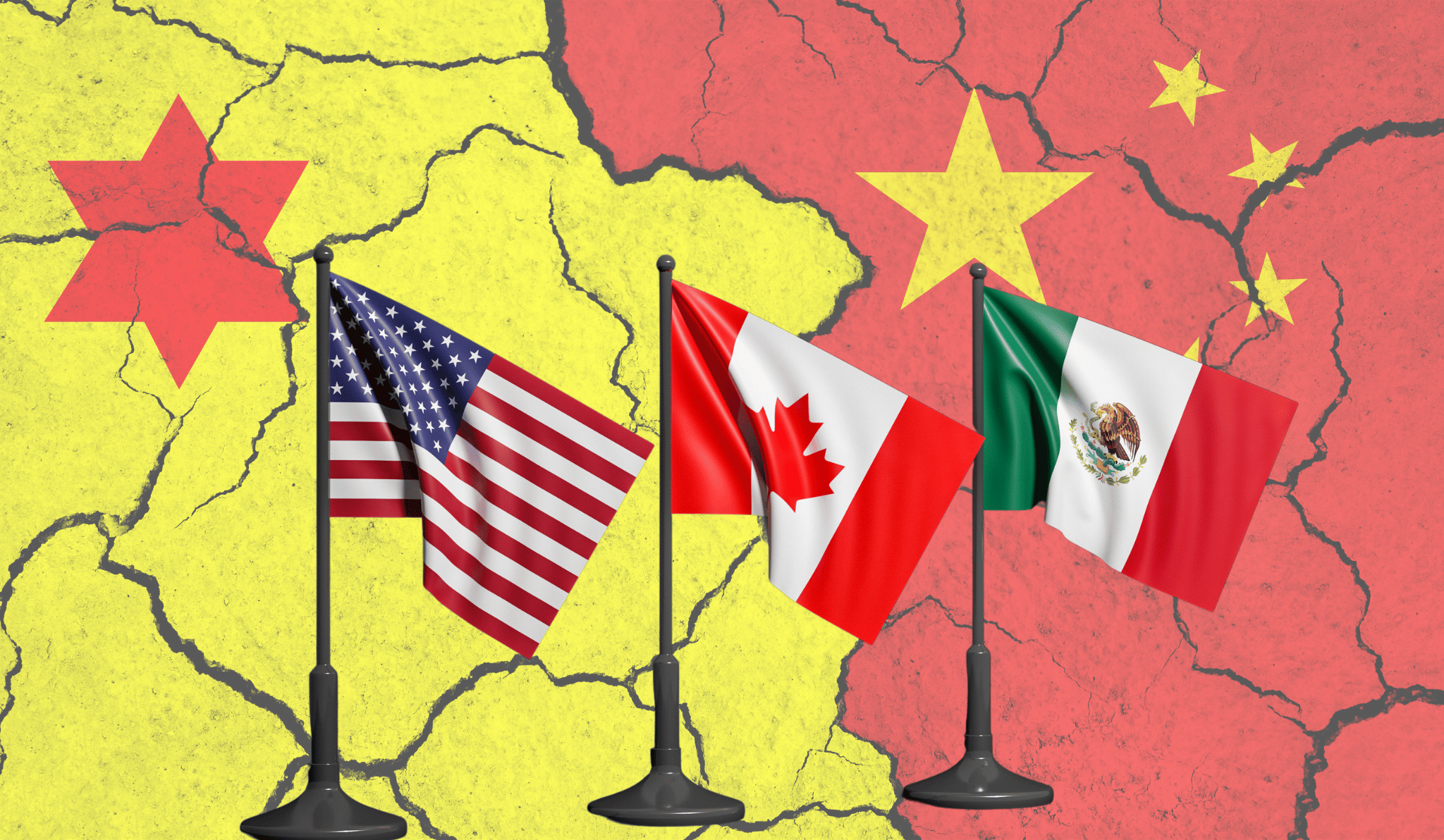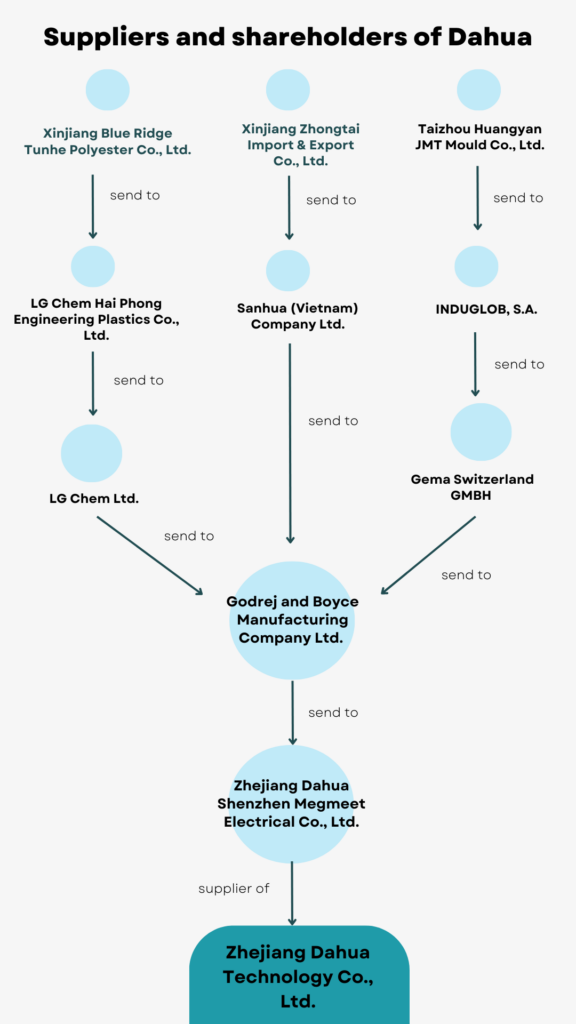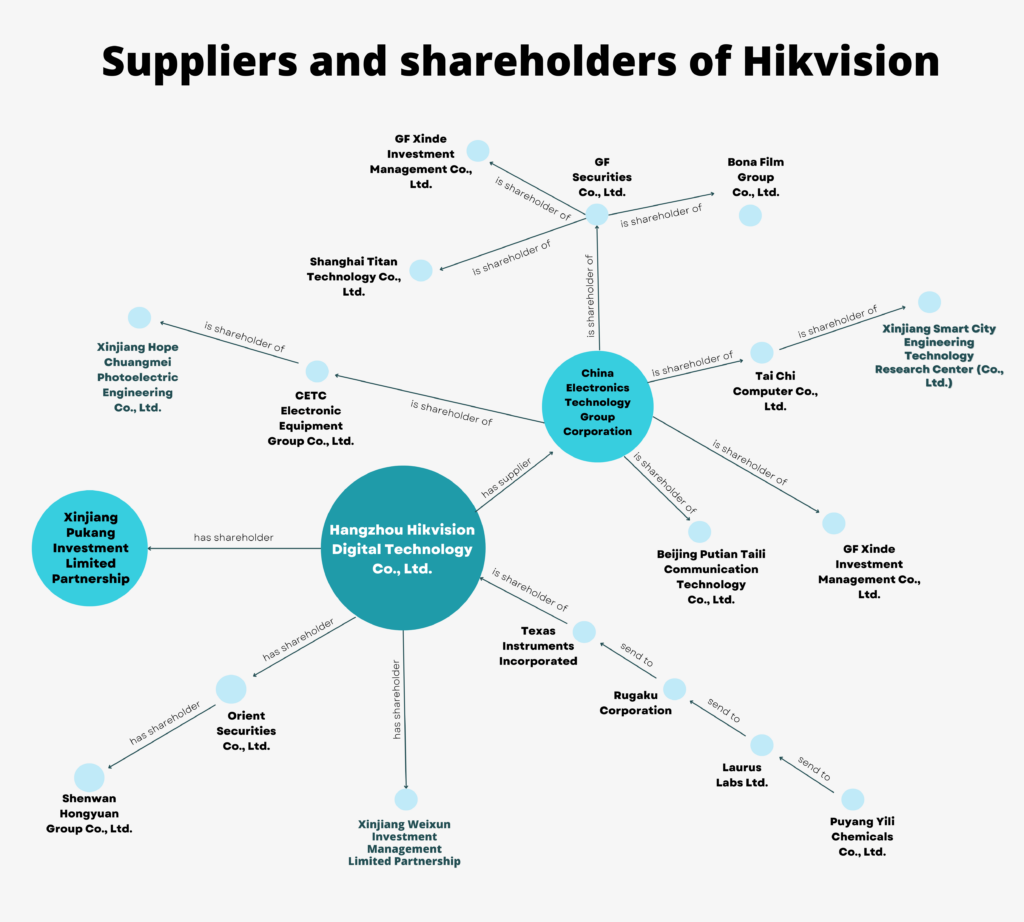
Mexico’s Agreement against Forced Labor: A Half Measure without a Budget, despite USMCA
9 de August de 2023
Translated from Spanish
The companies Dahua and Hikvision, which have Chinese State participation and are suppliers of video surveillance cameras for that government, include in their supply chains companies established in Xinjiang, a province where the use of forced labor and other human rights violations are reported. Although, with the signing of the United States-Mexico-Canada Agreement (USMCA), these countries agreed to prohibit the importation of products made totally or partially with forced labor, state and municipal governments in Mexico continue to acquire cameras from these brands. Dahua and Hikvision are just one example of what the Mexican Secretariat of Labor and Social Welfare (STPS) should be monitoring with regards to companies linked to areas where forced labor is often used. However, the STPS does not have a budget to implement this part of the USMCA, which is why the work must be absorbed by the General Directorate of Institucional Relations, according to freedom of information requests submitted by Empower. This obstacle to the operations of the Secretariat results in Mexico continuing to import, and people consuming, without knowing it, products possibly made with forced labor.
By Elizabeth Rosales
Between June 2022 and June 2023,1“Uyghur Forced Labor Prevention Act Statistics,” U.S. Customs and Border Protection, June 2023, www.cbp.gov/newsroom/stats/trade/uyghur-forced-labor-prevention-act-statistics. the United States rejected the importation of 872 shipments of goods of Chinese origin valued at 1.64 billion dollars after determining that forced labor was used in their manufacture. Mexico, like the United States and Canada, has the obligation to prevent these types of products from entering the country, according to international agreements, but, three years after the USMCA came into force, no open cases are being investigated, no budget has been allocated to carry it out, and no tangible progress has been made in Mexico.
The task of investigating the supply chain of products that may have been made with forced labor belongs to the General Directorate of Institutional Relations of the Secretariat of Labor and Social Welfare (STPS), with four officials assigned to the responsible unit, which must also comply with the tasks it had before the Agreement that prohibits these imports came into force.2“ACUERDO que establece las mercancías cuya importación está sujeta a regulación a cargo de la Secretaría del Trabajo y Previsión Social,” Diario Oficial de la Federación, 17 February 2023, https://dof.gob.mx/nota_detalle.php?codigo=5679955&fecha=17/02/2023.
In Mexico, the STPS defines forced labor as cases where deception, isolation or restriction of movement, intimidation, threats, or withholding of wages, among other situations, are used by employers.
A first obstacle to implementing the Agreement against the Importation of Products made with Forced Labor is that, upon receiving a complaint, which can be made by an individual or entity legally constituted in Mexico that presents evidence justifying the suspicion of forced labor, the STPS must ask the country of origin of the product to confirm or deny that human rights were violated. Thus, its results could be called into question when there are differences between what each country understands as forced labor and when the companies that use it have State participation from countries that will never admit it, as Empower found for this article, which is the second in a special series about forced labor.
Under the Agreement, which came into force in May, the STPS would have to investigate whether or not forced labor was used in the production of a product, either of its own initiative or because someone reports a case and presents reasonable evidence.
So far, the Directorate General of Institutional Relations, which absorbed the responsibilities of this agreement, does not have a budget allocated to implement it; however, it has not received requests for investigation nor has it published criteria for conducting investigations on its own. In addition, the Agreement establishes that the resolutions (determinations about whether a company used forced labor) will fall under the responsibility of the country of origin of the product or, failing that, will depend upon the evidence presented by the importing companies.
When asked by Empower through freedom of information requests which countries have agreements with Mexico to carry out these measures, the STPS limited itself to replying that collaborations with other countries “will be on a case-by-case basis.”
Xinjiang, hot spot
For this article Empower continued investigating two firms partially controlled by the Chinese Government, Dahua and Hikvision, and companies that supply state governments in Mexico, as we reported in “Ciudad Juárez acquires video surveillance equipment from Chinese companies banned by the U.S.” Both Chinese companies were found to have suppliers in Xinjiang, a region in northwest China where journalists and civil society organizations such as Human Rights Watch denounce the existence of prisons or indoctrination camps for Muslims, where they are allegedly tortured and forced to work, as in the specific case of the Uyghur community in East Turkestan, popularly known as the Xinjiang Autonomous Region. One of these technology firms also has other shareholding companies located in that region.
In the United States and Canada, the other two signatories of the USMCA, red flags alert authorities to the possibility of forced labor, such as a product having manufacturers in their supply chain based in Xinjiang.
So far, Dahua and Hikvision, whose devices are used to monitor the Xinjiang camps, are not known to use forced labor directly in their supply chains, but Empower found that they do rely indirectly on labor in Xinjiang, which in itself is an indicator of risk that should be investigated — by the STPS, in Mexico —, according to Darren Byler, a researcher specializing in forced labor and the oppression experienced by Uyghurs in China, and an academic at Simon Fraser University in Canada.
“I do think it’s a red flag because, as part of the ‘mass detention’ system in Xinjiang, many people are put to work in coercive conditions, especially minorities, and, given that [China] is not transparent in terms of allowing due diligence processes to take place to look at working conditions, contracts, and so on, it’s impossible to prove that they don’t use forced labor,” Byler said in an interview with Empower.
In his opinion, any product made with labor from Xinjiang would have to be subject to questions about the use of these labor schemes. And both Dahua and Hikvision have supply chains in which Xinjiang appears.
Supply chains are the relationship between the companies involved in the production of the same product, beginning with the company that produces the raw material, through the one that transforms it into a final product, to the one that distributes it to the customer. In this regard, the USMCA specifies in its labor chapter that the commitment to ban products made with forced labor includes those that were totally or partially made under these schemes, in order to eradicate any type of violence against workers.3“Capítulo 23 laboral del T-MEC,” Reforma Laboral México, 2019, www.reformalaboralmexico.com/wp-content/uploads/2019/04/23Laboral.pdf.
For this reason, it would be sufficient for any link of forced labor in a supply chain for it to be a cause for risk and for this clause of the USMCA to come into effect, as is the case of Dahua and Hikvision.
Dahua’s parent company is Zhejiang Dahua Technology Co. Ltd., a publicly-traded company listed on the Shenzhen Stock Exchange (SHE:002236), which, according to import and export records consulted by Empower, receives supplies indirectly from three companies located in Xinjiang.
These are Xinjiang Blue Ridge Tunhe Polyester Co. Ltd.,4Dahua has Shenzhen Megmeet Electrical Co. as its supplier, which receives materials from Godrej and Boyce Manufacturing Company, and the latter from LG Chem Ltd., which receives supplies from Xinjiang Blue Ridge Tunhe Polyester Co. Ltd. See: “LG Chem Hai Phong – Xinjiang Blue,” 2019-2023, share.mayfirst.org/s/9STxTYo4YNBoaK9; “Godrej and Boyce – LG Chem,” 2020-23, share.mayfirst.org/s/GTqqo5S9ySirEH6; and “Shenzhen Megmeet Electrical Co. Ltd. – Godrej and Boyce,” 2018-23, share.mayfirst.org/s/epyNF5Cg9QkK6AT. whose goods are processed and transformed by three other companies, from Vietnam, India, and China, before reaching Dahua’s parent company.
Another indirect supplier is Xinjiang Zhojngtai Import & Export Co. Ltd.,5Godrej and Boyce Manufacturing Company also receives supplies from Sanhua Company Limited, which receives materials from Xinjiang Zhojngtai Import & Export Co. Ltd. See: “Sanhua -Xinjiang Zhongtai,” 2019-23, share.mayfirst.org/s/98BnKym6oApFYBc; and “Sanhua – Godrej and Boyce,” 2020-23, share.mayfirst.org/s/jJE7oKM5TW6G7iP. which sends materials to a company in Vietnam, which does the same to another company in India and finally to China.
The third indirect supplier of Zhejiang Dahua Technology Co. is Taizhou Huangyan JMT Mould, Co. Ltd.,6Godrej and Boyce Manufacturing Company also has Gema Switzerland GMBH as its supplier, which receives materials from Induglob, S.A., and the latter from Taizhou Huangyan JMT Mould Co. Ltd., whose address is in Xinjiang. See: “Induglob – Taizhou,” 2018-23, share.mayfirst.org/s/csDCAnKtrYpiZ9D; and “Godrej and Boyce – Gema Switzerland,” 2018-23, share.mayfirst.org/s/jNWRW4SKjmEo3MY. which sends its products first to a company in Ecuador and then to the same company in India as in the previous cases, which finally delivers in China to Dahua’s parent company.
The three companies located or operating in Xinjiang and indirect suppliers of Dahua are engaged in the supply of PVC resins, which is a plastic derivative, industrial chemicals such as caustic soda, and molds for electronic parts.
As for Hikvision, its parent company, Hangzhou Hikvision Digital Technology Co. Ltd., which is also listed on the Shenzhen Stock Exchange (SHE:002415), lists two Xinjiang-based companies as shareholders: Xinjiang Weixun Investment Management Limited Partnership, with 4.82% of the shares, and Xinjiang Pukang Investment Limited Partnership, with 1.95%.7“2021 Quarter 1 Report January to March 2021,” Hikvision, 17 April 2021, pg. 5, share.mayfirst.org/s/yBEEtyoXzQPdFaL.
In addition, Hikvision indirectly includes in its supply chain Puyang Yili Chemicals Co. Ltd.,8Puyang Yili Chemicals Co. Ltd. is a supplier of Laurus Labs Limited, which in turn is a supplier to Rigaku Corporation, and the latter to Texas Instruments Incorporated, a supplier of Hikvision. See: “Puyang Yili – Laurus Labs,” 2022-23, share.mayfirst.org/s/45C9DfwjxYYJ8Xt; “Laurus Labs – Rigaku,” 2018-23, share.mayfirst.org/s/deptsQpzK2bwB3r; “Rigaku – Texas Instruments,” 2018-23, share.mayfirst.org/s/7pCKNeyrMjdYfZW; and “Texas Instruments – Hikvision,” Platform Partner, 2023, us.hikvision.com/en/partners/technology-partners/platform-partner. which operates in Xinjiang and produces chemicals that are processed in India, Japan, and the United States before reaching Hikvision. Also, it includes China Electronics Technology Group Corporation as a supplier, which has shares in seven companies in Xinjiang.
According to the U.S. Department of Labor, around 100,000 Uyghurs are subjected to forced labor in Xinjiang’s “re-education” camps and Chinese inputs such as silicon, used in electronics, are included in a list by the U.S. Department of Labor’s Office of International Labor Affairs9“Against their will: the situation in Xinjiang,” U.S. Department of Labor, undated, www.dol.gov/agencies/ilab/against-their-will-the-situation-in-xinjiang. of goods produced with forced labor.
Dahua and Hikvision in Mexico
In the article “Ciudad Juárez acquires video surveillance equipment from Chinese companies banned by the U.S.,”10“Ciudad Juárez acquires video surveillance equipment from Chinese companies banned by the U.S.,” Empower Journalism, 7 June 2023, empowerllc.net/en/2023/06/07/surveillance-border-dahua-hikvision. we reported that municipalities in four states along the northern border of Mexico have technology with facial recognition capabilities and that at least two of them acquired Dahua and Hikvision cameras, banned in the United States due to the risk of espionage by the Chinese Government. The purchases were made through Mexican companies that acted as intermediaries for the Chinese firms.
In the case of the purchase made by Ciudad Juárez, Chihuahua, of the company INT Intelligence and Telecom Technologies Mexico, S.A. de C.V. by the municipal Public Security Secretariat, it was not possible to specify whether this company provided cameras of both brands or only one of them, because the contract does not provide details; however, the agency did mention them both in its response to a freedom of information request. Upon investigating the supplier, Empower discovered that its legal representative in 2013, José Rolando Baca Minutti, and a shareholder, José Ignacio Román Moreno, have faced at least one labor lawsuit for non-payment of overdue wages and other benefits,11“Demanda Laboral. Ronaldo Neri Fierros Vs Intelco, Soluciones de Monitoreo, S.A. de C.V.”, Club Ensayos, 8 August 2011, www.clubensayos.com/Ciencia/Demanda-Laboral/39193.html. which also implies forced labor, according to the definitions of the International Labor Organization (ILO),12“Guía para la instrumentación del mecanismo para restringir la importación de mercancías producidas con trabajo forzoso u obligatorio,” Gobierno de México, May 2023, www.gob.mx/cms/uploads/attachment/file/826091/GUI_A_INSTRUMENTACIO_N_TF_VF_2.1.pdf. which are used as a frame of reference for the USMCA.13“Capítulo 23 – Laboral del T-MEC,” Foreign Trade Information System, undated, www.sice.oas.org/Trade/USMCA/Spanish/23Laboral.pdf.
Empower requested a comment from Baca Minutti for this article, but he did not respond. Román Moreno, on the other hand, could not be reached by any means.
Meanwhile, in China, both Dahua and Hikvision have denied involvement in the human rights violations linked to Xinjiang, as have Chinese Government representatives who have denied the existence of the camps where Muslim people claim to have been locked up and tortured under accusations of terrorism risks.
But survivors and a report submitted to the United Nations (UN) point to sufficient evidence to conclude that human rights violations, including forced labor, indeed take place in Xinjiang.
“Re-education” camps and forced labor in China
One of the most public testimonies about the Chinese Government’s repression of Uyghurs is that of Mihrigul Tursun,14“My experience in a Chinese Government Concentration Camp,” Muslim Community Center, 3 February 2023, www.youtube.com/watch?v=qTE8SJFQ8iU. a Muslim woman who, in 2015, was detained and separated from her three newborn children after traveling to China from Egypt, where she lived, to visit her family in Xinjiang.
In a testimony obtained by the East Bay Muslim Community Center, in the United States, Tursun tells how, for more than a year, she was held in concentration camps, officially called “re-education” camps, where she was interrogated, tortured, and sterilized against her will under accusations of terrorism solely because she is Muslim.
“The conditions in these camps are very bad; we can’t drink water, we can’t shower, we can’t leave our room, women have our heads shaved, and we are handcuffed, waiting for our turn to die,” said Mihrigul Tursun, who managed to escape with the help of her husband and the Egyptian government. In 2018, she emigrated to the United States.
The camps described by Tursun have been highlighted by human rights organizations and journalists as well as by governments that maintain trade relations with China and have imposed sanctions or restrictions against goods produced in Xinjiang, on the grounds that crimes against humanity, including forced labor schemes, are being committed there.
But Chinese Government representatives deny the detention of Muslim minorities.
“First of all, I want to make it clear that there have been no so-called ‘concentration camps’ in Xinjiang. However, some foreign politicians and media with ill intentions have labeled vocational education and training centers in Xinjiang as ‘concentration camps,’” said Elijan Anayat, spokesman of the Information Office of the Xinjiang Uyghur Autonomous Region People’s Government, at a press conference in 2021.15“The Press Conference on Xinjiang-related Issues in Beijing,” Consulate-General of the People’s Republic of China in Jeddah, 13 January 2021, jeddah.china-consulate.gov.cn/eng/zt/xjfk/202101/t20210117_5538592.htm.
The public official explained to the media that “vocational education and training centers” in Xinjiang were “actually schools with a deradicalization character” and no different in essence from “community correction centers.”
Empower requested an interview or comment from the Embassy of the Republic of China in Mexico, but it did not respond to several attempts of contact via telephone, e-mail, or a visit to its office in Mexico City.
In August 2022, modern slavery specialist Tomoya Obokata reported to the UN that it was “reasonable to conclude” the use of forced labor in the Xinjiang region.16“Contemporary forms of slavery affecting persons belonging to ethnic, religious and linguistic minority communities: report of the Special Rapporteur on Contemporary Forms of Slavery, Including Its Causes and Consequences, Tomoya Obokata,” UN Digital Library, August 2022, share.mayfirst.org/s/JLSm8d9pam7bn2D.
So far, countries such as the United States, Canada, the United Kingdom, and the European Union have already implemented sanctions17“Reasonable to conclude forced labour in China: UN expert,” Al Jazeera, 18 August 2022, www.aljazeera.com/economy/2022/8/18/forced-labour-claims-in-chinas-xinjiang-reasonable-un-expert. against goods from Xinjiang and signed international agreements to detect the use of forced labor in supply chains in general.
Mexico’s situation with China
“Everyone knows someone who shops at Alibaba, Shein, and so on,” said Cuauhtémoc Mendoza, a lawyer specializing in international public, labor, civil, trade, and tax law, who pointed out that, under ILO criteria, these companies are examples of export products possibly made with forced labor.
Lawmakers and activists have asked Chinese brands in the textile and apparel industries, such as fashion retailer Shein, to prove that they do not use forced labor in their supply chains, as around 90% of the cotton produced in China comes from Xinjiang,18“Shift in Geography of China’s Cotton Production Reshapes Global Market,” United States Department of Agriculture, 5 December 2022, www.ers.usda.gov/amber-waves/2022/december/shift-in-geography-of-china-s-cotton-production-reshapes-global-market. which has alerted consumers that fast fashion, in addition to polluting, is marketed at low prices, taking advantage of labor exploitation.
But the textile industry is not the only one that authorities such as the U.S. Department of Agriculture and the U.S. Customs and Border Protection (CBP) point to as being susceptible to the use of forced labor. Products made from silicon, such as some computer parts and solar panels, are also subject to inspection in the United States.
In 2020 alone, Mexico imported 73,609,278,000 USD worth of goods from China, or 19% of all imports to Mexico that year, where the majority were electronic components and appliances, according to the Statistical Information Consultation System of the Secretariat of Economy.19“Sistema de Consulta de Información Estadística,” Secretaría de Economía, 2008-20, www.economia-snci.gob.mx/sic_php/pages/estadisticas.
The problem, according to experts such as researcher Darren Byler, is that countries where the government promotes the use of forced labor will not publicly admit that they resort to these schemes and, in the case of Mexico, the first thing the STPS will do when faced with a suspicion of forced labor is to request the cooperation of the country of origin to determine if forced labor was used.
“It makes sense to think of the State as a good actor to determine these cases because forced labor is illegal and almost all countries have regulations about that kind of thing… [But], in this case, the State is in fact in charge of forced labor; it is the one that promotes it, implements it, and prevents the working conditions from being disclosed. We have to understand that, in this case, the [Chinese] State is not an independent entity that can regulate this, it’s in fact the one committing it,” said Byler.
But Xinjiang is not the only region where the use of forced labor has been reported. India, Myanmar, and Nepal are other examples in Asia, where most of the world’s forced labor is concentrated, according to the ILO.20“Forced labour, modern slavery and human trafficking,” OIT, 2021, www.ilo.org/global/topics/forced-labour/lang—en/index.htm. For this reason, Mendoza, a labor law specialist, considers it important for the STPS to define criteria for starting investigations of its own initiative, beginning with those countries in critical situations such as China.
On multiple occasions Empower requested an interview with the STPS, and sent written questions regarding issues such as the criteria for the Secretariat initiating their own investigations even if there is no complaint, but it did not respond by the time of publication.
According to information obtained by Empower through freedom of information requests, as of today, the STPS has not issued any resolution to prohibit the importation of any product, since it has a period of 180 working days, plus the possibility of extension, for each case and, as of June 20, it had not received “any request for review filed by an individual or entity legally constituted in Mexico, nor has it received information to initiate an informal investigation without the existence of a complaint.”21“STPS/UPLRI/DGRI/0417/2023,” Plataforma Nacional de Transparencia, 20 June 2023, share.mayfirst.org/s/9FwNMCcGqpwH9kz
The recent departure of Luisa María Alcalde as head of the STPS should not affect the process for the implementation of the Agreement that prohibits the importation of products made with forced labor, according to labor lawyer Cuauhtémoc Mendoza, but he observed that for the moment the Agreement has not been a priority for the Secretariat.
“The truth is that the structure of the Secretariat of Labor is the same, so much so that the undersecretary was left as secretary, but it must be made clear that this is not a priority for the STPS or for the Secretariat of Economy, when it should be,” Mendoza commented.
Mexico, in the event of non-compliance with the Agreement, would not automatically be subject to a sanction, but Mendoza warned that the United States or Canada could call for a consultation and subsequently a panel to analyze the non-compliance and determine what measures to take.
“What can happen is that [the U.S. or Canada] may take measures that are not formally in the USMCA, such as ‘did you not comply with the Agreement? Then I will impose a sanction derived from that,’ such as tariff increases that are outside the USMCA or products that may affect Mexico’s productivity, as happened with steel, tuna, or avocado,” explained Mendoza.
In addition to the lack of budget and a team of four public officials assigned to the unit that now has to implement the Agreement in addition to developing its functions, there is the political situation of the change of government at the presidential level in 2024, which together could translate into obstacles to full implementation.
In the next article in this series on forced labor, Empower will focus on the process of filing petitions to investigate the possible use of forced labor in imported products.
1 “Uyghur Forced Labor Prevention Act Statistics,” U.S. Customs and Border Protection, June 2023, www.cbp.gov/newsroom/stats/trade/uyghur-forced-labor-prevention-act-statistics.
2 “ACUERDO que establece las mercancías cuya importación está sujeta a regulación a cargo de la Secretaría del Trabajo y Previsión Social,” Diario Oficial de la Federación, 17 February 2023, https://dof.gob.mx/nota_detalle.php?codigo=5679955&fecha=17/02/2023.
3 “Capítulo 23 laboral del T-MEC,” Reforma Laboral México, 2019, www.reformalaboralmexico.com/wp-content/uploads/2019/04/23Laboral.pdf.
4 Dahua has Shenzhen Megmeet Electrical Co. as its supplier, which receives materials from Godrej and Boyce Manufacturing Company, and the latter from LG Chem Ltd., which receives supplies from Xinjiang Blue Ridge Tunhe Polyester Co. Ltd. See: “LG Chem Hai Phong – Xinjiang Blue,” 2019-2023, share.mayfirst.org/s/9STxTYo4YNBoaK9; “Godrej and Boyce – LG Chem,” 2020-23, share.mayfirst.org/s/GTqqo5S9ySirEH6; and “Shenzhen Megmeet Electrical Co. Ltd. – Godrej and Boyce,” 2018-23, share.mayfirst.org/s/epyNF5Cg9QkK6AT.
5 Godrej and Boyce Manufacturing Company also receives supplies from Sanhua Company Limited, which receives materials from Xinjiang Zhojngtai Import & Export Co. Ltd. See: “Sanhua -Xinjiang Zhongtai,” 2019-23, share.mayfirst.org/s/98BnKym6oApFYBc; and “Sanhua – Godrej and Boyce,” 2020-23, share.mayfirst.org/s/jJE7oKM5TW6G7iP.
6 Godrej and Boyce Manufacturing Company also has Gema Switzerland GMBH as its supplier, which receives materials from Induglob, S.A., and the latter from Taizhou Huangyan JMT Mould Co. Ltd., whose address is in Xinjiang. See: “Induglob – Taizhou,” 2018-23, share.mayfirst.org/s/csDCAnKtrYpiZ9D; and “Godrej and Boyce – Gema Switzerland,” 2018-23, share.mayfirst.org/s/jNWRW4SKjmEo3MY.
7 “2021 Quarter 1 Report January to March 2021,” Hikvision, 17 April 2021, pg. 5, share.mayfirst.org/s/yBEEtyoXzQPdFaL.
8 Puyang Yili Chemicals Co. Ltd. is a supplier of Laurus Labs Limited, which in turn is a supplier to Rigaku Corporation, and the latter to Texas Instruments Incorporated, a supplier of Hikvision. See: “Puyang Yili – Laurus Labs,” 2022-23, share.mayfirst.org/s/45C9DfwjxYYJ8Xt; “Laurus Labs – Rigaku,” 2018-23, share.mayfirst.org/s/deptsQpzK2bwB3r; “Rigaku – Texas Instruments,” 2018-23, share.mayfirst.org/s/7pCKNeyrMjdYfZW; and “Texas Instruments – Hikvision,” Platform Partner, 2023, us.hikvision.com/en/partners/technology-partners/platform-partner.
9 “Against their will: the situation in Xinjiang,” U.S. Department of Labor, undated, www.dol.gov/agencies/ilab/against-their-will-the-situation-in-xinjiang.
10 “Ciudad Juárez acquires video surveillance equipment from Chinese companies banned by the U.S.,” Empower Journalism, 7 June 2023, empowerllc.net/en/2023/06/07/surveillance-border-dahua-hikvision.
11 “Demanda Laboral. Ronaldo Neri Fierros Vs Intelco, Soluciones de Monitoreo, S.A. de C.V.”, Club Ensayos, 8 August 2011, www.clubensayos.com/Ciencia/Demanda-Laboral/39193.html.
12 “Guía para la instrumentación del mecanismo para restringir la importación de mercancías producidas con trabajo forzoso u obligatorio,” Gobierno de México, May 2023, www.gob.mx/cms/uploads/attachment/file/826091/GUI_A_INSTRUMENTACIO_N_TF_VF_2.1.pdf.
13 “Capítulo 23 – Laboral del T-MEC,” Foreign Trade Information System, undated, www.sice.oas.org/Trade/USMCA/Spanish/23Laboral.pdf.
14 “My experience in a Chinese Government Concentration Camp,” Muslim Community Center, 3 February 2023, www.youtube.com/watch?v=qTE8SJFQ8iU.
15 “The Press Conference on Xinjiang-related Issues in Beijing,” Consulate-General of the People’s Republic of China in Jeddah, 13 January 2021, jeddah.china-consulate.gov.cn/eng/zt/xjfk/202101/t20210117_5538592.htm.
16 “Contemporary forms of slavery affecting persons belonging to ethnic, religious and linguistic minority communities: report of the Special Rapporteur on Contemporary Forms of Slavery, Including Its Causes and Consequences, Tomoya Obokata,” UN Digital Library, August 2022, share.mayfirst.org/s/JLSm8d9pam7bn2D.
17 “Reasonable to conclude forced labour in China: UN expert,” Al Jazeera, 18 August 2022, www.aljazeera.com/economy/2022/8/18/forced-labour-claims-in-chinas-xinjiang-reasonable-un-expert.
18 “Shift in Geography of China’s Cotton Production Reshapes Global Market,” United States Department of Agriculture, 5 December 2022, www.ers.usda.gov/amber-waves/2022/december/shift-in-geography-of-china-s-cotton-production-reshapes-global-market.
19 “Sistema de Consulta de Información Estadística,” Secretaría de Economía, 2008-20, www.economia-snci.gob.mx/sic_php/pages/estadisticas.
20 “Forced labour, modern slavery and human trafficking,” OIT, 2021, www.ilo.org/global/topics/forced-labour/lang—en/index.htm.
21 “STPS/UPLRI/DGRI/0417/2023,” Plataforma Nacional de Transparencia, 20 June 2023, share.mayfirst.org/s/9FwNMCcGqpwH9kz.






